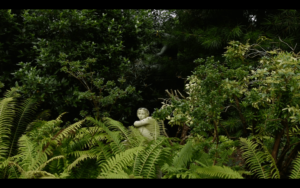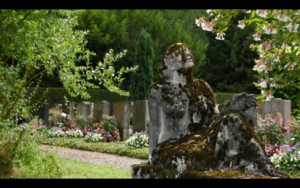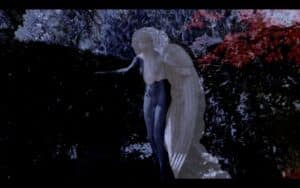


Screened for the audience at the international conference IMAGES OF NATURE (Zurich),
May 8, 2021
The short film shows cemeteries where sculptures of women in sensual postures act as hosts and subordinates of the teeming plant life. The sculptures exhibit varying states of decay. Many are covered with layers of moss and lichen, giving the stone an organic layer, almost a living skin. The images oscillate between stillness and motion, suggesting not only the suspension between life and death but also the vitalist potential of film as a medium that can “preserve” life.
This peculiar placement of the female shape offers a departure point for reflection on its shifting functions from mythical narratives to contemporary ecofeminism.
A sense of commodification hovers over the use of the female shape in the cemetery sculptures. They draw on the symbolic connection of the woman to nature, love, and the cycle of life, but also on the notion – as Edgar Allan Poe wrote – that the death of a beautiful woman is unquestionably the most poetic topic in the world. There is something slightly jarring about these sculptures and their use of naked, potentially erotic female bodies as a counterpoint to death through the conventional association of the woman with life and nature (an association that traditionally served to exclude women from the domains of intellectual and political life).
But if the stone as a material is intended to withstand time, the plants expose the human claim to a physical presence through symbols as feeble. As if in defiance of the symbolic orders created by humans, the plants assert their silent agency, engulfing everything from stone to earth. They introduce and offer a standpoint beyond the polarity of the sexes inherent in the sculptures, pointing to an agency and forces altogether beyond the anthropocentric volition and narrative. As the anthropocentric viewpoint is abandoned, all the power and symbolism of the human order seem to lose their validity and relevance.
Long camera takes sometimes make it hard to discern whether the image is still or moving, blurring the boundaries between film and photography. Then something in the background moves minimally – or does it? The uncertainty reclaims animism as a possible principle at work: “it is another nature which speaks to the camera rather than to the eye… a space informed by human consciousness gives way to a space informed by the unconscious” (Walter Benjamin). Is our mind playing tricks on us? Or has something in the still image come to life? The “optical unconscious” of the medium is also at work here, excavating the cultural unconscious and its bias, which favors a standpoint of anthropocentric agency.